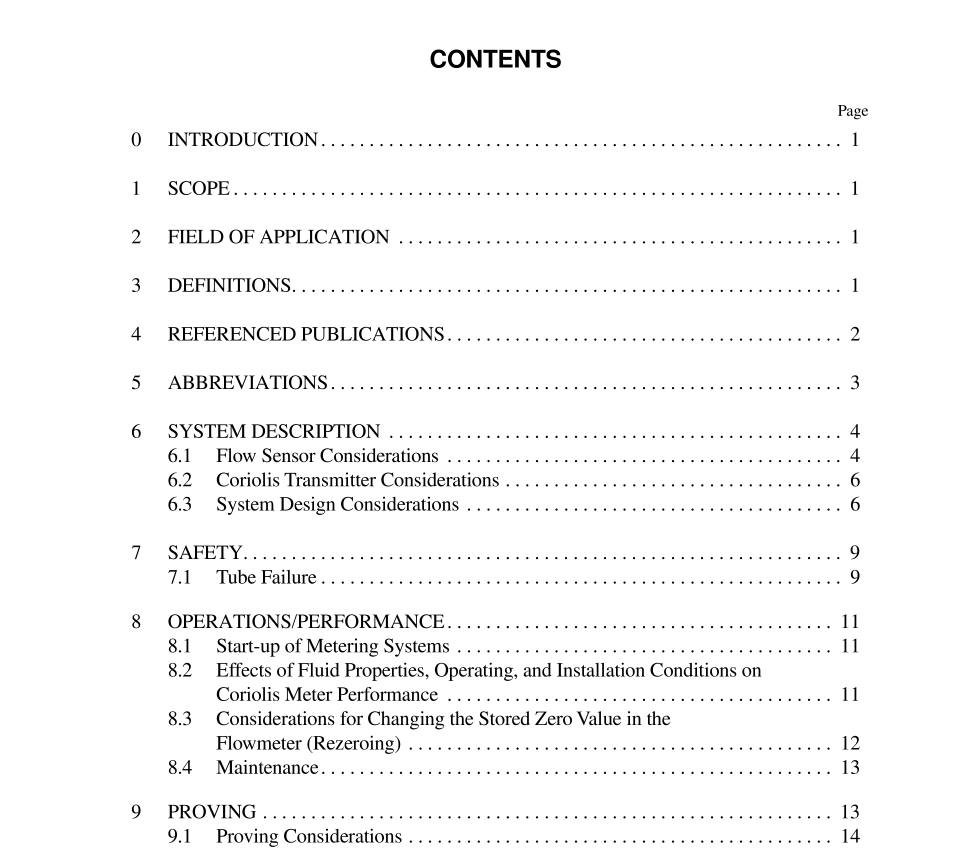API MPMS 5.6 pdf download

API MPMS 5.6 pdf download.Section 6—Measurement of Liquid Hydrocarbons by Coriolis Meters
3 Definitions
3.1 accessory equipment: Any additional electronic or mechanical computing, display, or totalization equipment used as part of the metering system.3.2 base conditions: Defined pressure and temperature conditions used in the custody transfer measurement of fluid volume and other calculations. Base conditions may be defined by regulation or contract. In some cases, base condi- tions are equal to standard conditions, which within the U.S. are usually 14.696 psia and 60°F, and in other regions 101.325 kPa (absolute) and 15°C. 3.3 base density: The density of the fluid at base condi- tions. 3.4 calibration: The process of utilizing a reference standard to determine a coefficient which adjusts the output of the Coriolis transmitter to bring it to a value which is within the specified accuracy tolerance of the meter over a specified flow range. This process is normally conducted by the manufacturer. 3.5 cavitation: Phenomenon related to and following flashing if the pressure recovers and the vapor bubbles col- lapse (implode). Cavitation will cause a measurement error and can damage the sensor. 3.6 Coriolis meter: Also referred to as Coriolis mass meter or Coriolis force flowmeter. A Coriolis meter is a device which by means of the interaction between a flowing fluid and the oscillation of a tube(s), measures mass flow rate and density. The Coriolis meter consists of a sensor and a transmitter.3.7 Coriolis meter factor, mass or volume ( MF , MF m , MF v ): A dimensionless number obtained by dividing the actual quantity of fluid passed through the meter (as deter- mined by proving), by the quantity registered by the meter. For subsequent metering operations, the actual quantity is determined by multiplying the indicated quantity by the meter factor. 3.8 Coriolis transmitter: The electronics associated with a Coriolis meter which interprets the phase shift signal from the sensor, converts it to a meaningful mass flow rate (repre- sented in engineering units or a scaled value), and generates a digital or analog signal representing flow rate and/or quantity. Most manufacturers also use it to drive the sensor tubes, determine fluid density, and calculate a volumetric flow rate. 3.9 flashing: A phenomenon which occurs when the line pressure falls to or below the vapor pressure of the liquid, often due to local lowering of pressure because of an increase in the liquid velocity.3.12 K-factor: Pulses per unit quantity (volume or mass); a coefficient, entered in the accessory equipment by a user, which relates a frequency (mass or volume) input from the Coriolis transmitter to a flow rate. 3.13 manufacturer density calibration factor: A numerical factor which may or may not be used to address density sensitivity of each individual Coriolis meter sensor. It is unique to each sensor and derived during sensor cali- bration. When programmed into the transmitter, the density calibration factor(s) helps ensure that the meter performs to its stated specifications. Note: The Manufacturer Density Calibration Factor should not be confused with Density Meter Factor ( DMF ). 3.14 manufacturer flow calibration factor: A numer- ical factor which may or may not be used to address flow sensitivity of each individual Coriolis meter sensor. It is unique to each sensor and derived during sensor calibration. When programmed into the Coriolis transmitter, the flow calibration factor(s) helps ensure that the meter performs to its stated specifications. Note: The Manufacturer Flow Calibration Factor should not be con- fused with K-Factor or Meter Factor (MF) . 3.15 meter assembly: The Coriolis sensor and the Cori- olis transmitter used for the measurement of fluid. 3.16 pressure loss (pressure drop): The difference between upstream and downstream pressures due to the fric- tional and inertial losses associated with fluid motion in the entrance, exit, and internal passages of the flow meter or other specified systems and equipment.









